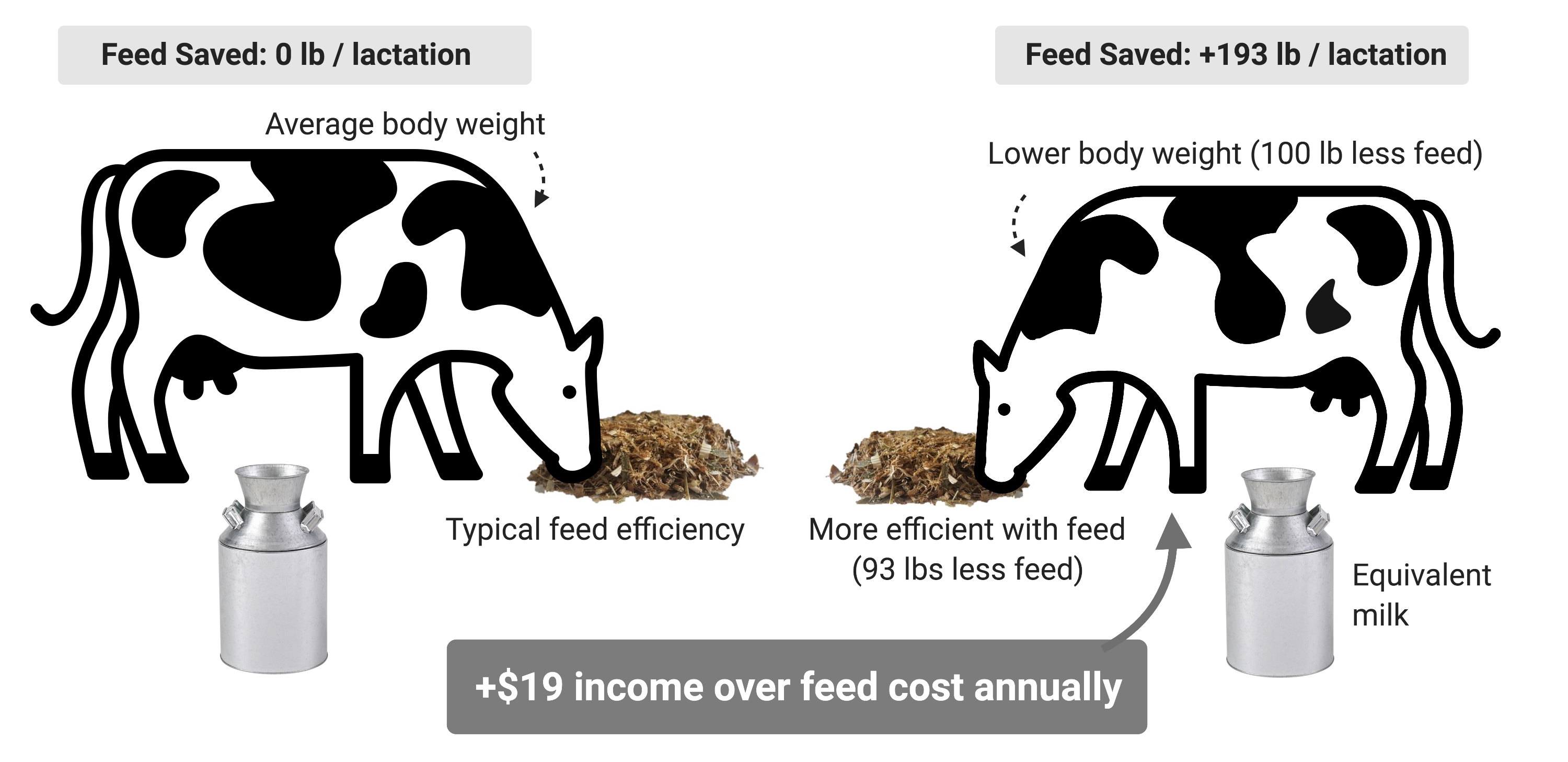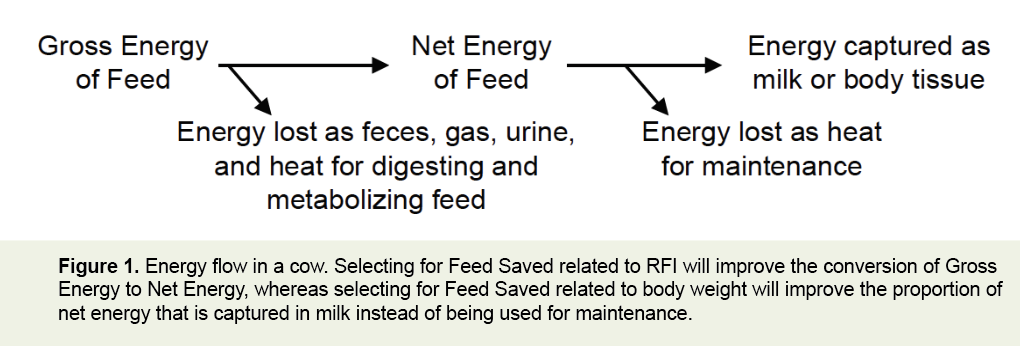Feed Saved - The next step in breeding a more efficient cow?
Introduction of the Feed Saved trait allows dairy producers to tackle feed costs though genetics.

Feed accounts for half the costs on most dairy farms. Thus, cows with greater feed efficiency, meaning those cows that need less feed for each pound of milk they produce, are likely to be more profitable. Cows that are more efficient also need less land per pound of milk and will produce less waste per pound of milk. They might also produce less methane per pound of milk. Thus, feed efficiency is a trait well worth considering as a breeding goal, but, until now, it has never been a trait we have focused on in our breeding goals.
That is about to change.
Since the 1990s, we have known that feed efficiency is a heritable trait, based on work from Europe. The problem, however, was that we don’t know the feed intake of individual cows on most commercial farms, and we need feed intake to calculate feed efficiency. Traditionally, to estimate the genetic breeding value of new dairy sires, we used data from thousands of his daughters, compared to their herdmates. So direct selection for feed efficiency was simply impossible. The advent of genomics has changed that. Genomics enables us to make faster progress for existing traits, like milk protein or fat yield, and to breed for new traits, like feed efficiency. To do that, however, we need a reference population of cows with known phenotypes for feed efficiency and known genotypes.
Ten years ago, we started a project in the U.S., with Michigan State University and the University of Wisconsin as leaders, to study the genomics of feed efficiency. Our team has both nutritionists and geneticists. We were able to obtain major funding from the UDSA National Institute of Food and Agriculture in 2010, and we now have funding from the U.S. Foundation for Food and Agriculture Research and the U.S. Council for Dairy Cattle Breeding (CDCB). Other team members include scientists from Iowa State
University, the University of Florida, and the UDSA Animal Genomics Improvement Lab in Maryland. Our goal is to measure feed efficiency on thousands of cows in research herds and develop a database of feed efficiency phenotypes and genotypes that can be used to develop genomic breeding values for feed efficiency.
After ten years of work, we have 5,200 cows in our database, and we are happy that feed efficiency is included as a trait as of the December 2020 genetic update. This trait will be called Feed Saved, a term coined by a dairy geneticists in Australia. Feed Saved is actually composed of two parts: 1) the feed saved when a cow is smaller and needs less feed for maintenance, and 2) the feed saved when a cow has a lower Residual Feed Intake (RFI). As long as the resulting daughters from this less-voracious cow produce at least as much milk, with the same protein and fat content, they will be more efficient at turning feed into milk components. To better understand Feed Saved, let’s consider its two parts separately.
Feed is saved when cows are smaller but continue to produce as much milk--they produce more milk per unit of body weight. Cows, like all animals, need some feed every day for maintenance--just to stay alive. The amount of feed energy needed for maintenance is directly related to the cow’s body weight. For years, we have been breeding and managing cows for greater milk production. As cows eat more feed, a greater proportion of their feed intake is used for milk and a smaller proportion is used for maintenance. This is commonly called the “Dilution of maintenance”. Today’s dairy cows produce 5 times more milk than their predecessors 80 years ago, and, although they are also a little larger and they eat more, their feed efficiency had doubled due to the dilution of maintenance.
Data from our current studies, along with other recent studies, indicates that the maintenance cost penalty assigned to larger cows in NM$ has been too small and should be doubled. This penalty includes extra feed expenses incurred by large animals during the rearing and dry periods, as well as added housing costs, but large cows receive credit for greater salvage and calf values. For U.S. dairy cattle, the maintenance requirements and associated rearing costs and salvage values are based on the body weight composite (BWC), which is comprised of five linear type traits: stature, strength, body depth, dairy form, and rump width. The new Feed Saved trait incorporates all of the above net costs associated with BWC.
Feed is saved when cows have lower residual feed intake (RFI)--they eat less than expected based on their milk production, body weight, and body weight change. When cows eat feed to obtain nutrients for maintenance or milk, they must first digest and metabolize feed ingredients to the metabolites that are actually used by cells for maintenance and milk synthesis. For energy, they convert the “Gross Energy” of the feed to “Net Energy” (see figure 1).
Some cows are more efficient at this than others. Those with a positive RFI eat more than expected; we cannot justify their greater intake, so they are less efficient. In contrast, cows with a negative RFI eat less than expected; thus, they are more efficient. Our studies have shown that the heritability of RFI is 17%, making it more heritable than foot/leg type traits (15%) and only slightly less heritable than milk yield (20%). So, it is clear that we can make progress on this trait. Of course, it is very important that selection for RFI does not decrease health or fertility or milk production. We typically focus on three energy needs when computing expected DMI and comparing the relative efficiency of dairy cows: energy required for lactation, energy required for maintenance, and energy required for body weight change (growth or added body condition), as shown in Figure 2.
To measure RFI, we measure milk yield, milk composition, body weight, body condition score, and DMI for approximately 42 days in mid-lactation. We chose the time period between 50 and 200 days-in-milk, because that’s when cows are in peak lactation, and when their body weights and body condition are relatively stable. We can compute the RFI of each cow from these data, by comparing her actual DMI with the expected DMI of a cow of equivalent body weight, milk yield, milk composition, body weight change, days-in-milk, and parity over the study period. All calculations are done within a cohort, where a cohort is cows fed the same diet at the same place at the same time. RFI is the deviation from expected based on the cohort – this is the same concept as the deviation from herdmate that we’ve used in routine genetic evaluations of other key traits for decades.
To keep genomic evaluations for RFI, and thus Feed Saved, up to date, we must continue measuring feed intake on individual cows every year for the reference population. This will continue to require significant investments of time, money, labor, and technology on research farms, but the resulting information can be used to compute PTAs for feed efficiency of all cows, bulls, heifers, and calves in the national population.
Incorporating Feed Saved into Net Merit
We expect Feed Saved to assist dairy producers in breeding cows of moderate size that can convert consumed feed into milk and body tissue even more efficiently than they do now. Said another way, it will help dairies avoid breeding cows that waste feed in achieving and maintaining excessive body size or waste too much energy as feces, gas, urine, and heat.
Mathematically, the formula for Feed Saved puts weights of -138 on PTAs for BWC and -1 on PTAs for RFI; because both weights are negative, larger values of Feed Saved are desirable. The standard deviation of PTA values for Feed Saved is about 109 pounds per lactation, so significant genetic variation exists between animals, and Feed Saved PTAs of the top 100 NM$ bulls range from -183 to +395 pounds per lactation. The genetic correlation of Feed Saved with milk production is near zero, due to the way RFI is computed, and correlations with health and fertility traits range from zero to slightly antagonistic – these traits will be monitored closely, to ensure that gains in feed efficiency are not accompanied by losses in health, fertility, or longevity. Reliabilities (REL) of Feed Saved will be a challenge, due to small size of the genomic reference population for RFI, and we expect average REL of Feed Saved for young, genome-tested calves to be about 37%.
On the other hand, the economic value of Feed Saved is quite large, and the relative economic weight proposed for eventually incorporating this new trait in the Lifetime Net Merit Index (NM$) is about 21% (roughly 40% for BWC and 60% for RFI). Net Merit will continue to focus on increasing milk protein and fat yields, but our expectation is that addition of Feed Saved into NM$ in the coming years will provide an extra $8 million per year in net profit to U.S. dairy farmers, and these gains will accumulate over time.
Introduction of routine CDCB genomic evaluations for Feed Saved is a big step forward, and the result of a decade of university research. Our work is not finished, though. Beyond adding roughly 750 new cows to the genomic reference population each year, we are collaborating with international partners who can contribute cows to a larger global reference population, developing proxies to predict DMI from inline milk analysis systems, wearable sensors, and computer vision algorithms, and carrying out intensive nutrition and physiology studies that will advance our understanding of metabolic regulation, methane emissions, health, and fertility. This work will advance continued improvements in the efficiency and sustainability of the dairy industry.





 Print
Print Email
Email





